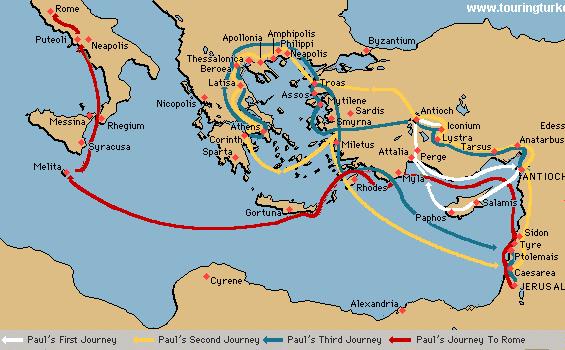Making the Acquaintance of the Early Apostles and Disciples
Copyright 2919 by Joan Berry
The difference between disciples and Apostles is that the Lord had specially commissioned the twelve Apostles in the first century but He has also commissioned His disciples to be witnesses of His wherever they go. One has apostolic authority while the others have discipleship authority to make disciples of others.
Among the twelve apostles chosen by Jesus, there were three sets of brothers: James the Greater and John the apostle; James the Younger and Jude; and Peter and Andrew. It should be noted that certain names were prominent in Jewish society such as: James, John, Judas, and Simon. This accounts for the custom of Jewish males having two names so as to distinguish one from one another. In the case of Matthew and James the Younger, each had a father named Alpheus. There was some speculation that these two were brothers. This is unlikely because the Scriptures are consistent in naming relationships and no scripture bears out that they were brothers. James the Just was not the brother of Jesus, for example. Joseph, Simon, Jude, and a James were cited in the New Testament (NT) as His brothers. Two of Jesus’ sisters were identified as Mary and Salome; both names were also prominent in the society.
Apostle Andrew [and Peter] was the son of Jonas who resided in Bethsaida and Capernaum. Andrew was a fisherman as well as his brother. He was a disciple of John the Baptist until the baptism of Jesus. Following that event, he became Jesus’ first disciple and remained so for the rest of his life. Also, Andrew was the first to have a Home and Foreign mission. He preached in Greece, Asia Minor, and Scythia. He was martyred in Achaea, Greece on an X-shaped cross. His symbol is an X-shaped cross or two crossed fish because he was a fisherman.
Apostle Bartholomew [or Nathaniel] was the son of Talmai [of a royal line] and he was well educated in the Scriptures and scholar of the Law. The family lived in Cana of Galilee. For a time he was a missionary in Armenia and then in India where he was martyred. His symbol is three parallel knives in remembrance of his death by being flayed.
Apostle James the Greater, Boanerge, the son of Zebedee and Salome, was a fisherman and lived in Bethsaida, Capernaum, and Jerusalem. He was the brother of John the Apostle. He preached in Jerusalem where he was beheaded by Herod in 44 C.E. becoming the first apostle martyr. His symbol is three shells, a stalt [walking stick], and a sword representing his missions along the shores, his travels, and how he was killed.
Apostle James the Lesser [or Younger] was the son of Alpheus (Cleophas) and Mary and lived in Galilee. He was the brother of the Apostle John and Joseph. James preached in Palestine and was martyred in Egypt by crucifixion and being sawed into pieces. The saw became his symbol.
Apostle John, Boanerge, was the son of Zebedee and Salome, brother of James the Greater, and the Beloved Disciple. He and his brother were known as the “Sons of Thunder.” He also was a fisherman, from a wealthy family and resided in Capernaum, Bethsaida, and Jerusalem. He was the author of the Gospel of John and John 1, 2, and 3. He preached in Asia Minor until the Emperor Domitian banished him to the isle of Patmos. After Domitian died, John was release from imprisonment and allowed to return to Ephesus where he governed churches in Asia until he died a natural death ca. 100 C. E. There was an attempt on John’s life when he was given a chalice of poison, but God intervened and saved him. His symbol is a chalice containing a snake.
Apostle Jude [also known as Thaddeus in Mark and Lebbeus in Matt.] was the son of Alpheus [Cleophas] and Mary and the brother of James the Younger. The family lived in Galilee. Jerome referred to Jude as “Triomious” meaning a man with three names. Jude preached at Edessa near the Euphrates River and other places. He supported Jesus in a big way; he wanted the world to know his Lord. He was killed at Ararat by arrows. His symbol is a ship whose sail bears a cross because he was a fisherman and Christian.
Judas Iscariot, the traitor, was the son of Simon who lived in Kerioth. He was the treasurer for the group of apostles. Judas apparently had ulterior motives for joining the group because he was a violent Jewish Nationalist who hoped that Jesus would establish an earthly kingdom and he would be a participant. He hanged himself after his treasonous act against Jesus. His symbol is a hangman’s noose or a purse with pieces of silver falling from it.
Apostle Matthias was chosen by lots to replace Judas Iscariot. He was with Jesus when He was baptized by John the Baptist and remained with Jesus until he ascended to Heaven. He preached on the shores of the Caspian Sea and Cappadocia [Turkey]. He was martyred by being beheaded by a scimitar. His symbol is a scimitar and a Bible.
Apostle Matthew [Levi] was the son of Alpheus and employed as a tax collector whom the populace hated. He lived in Capernaum. He was well educated and the first to write down the teachings of Jesus. His name means “Gift of God.” Matthew preached in Ethiopia and Egypt where he died as a martyr when King Hercanus had him killed with a battle axe. His symbol is three money bags and a battle axe as a reminder that he was a tax collector before following Jesus and how he was killed
Apostle Simon Peter (or Cephas) was the only apostle mentioned as being married. He is the son of Jonas who resided in Bethsaida and Capernaum. He was a fisherman as well as his brother, Andrew. His name, Simon, means rock from the Greek; Peter also means rock from the Arabic. He was the first to confess that Jesus was the Son of God and Peter was on the Mount of Transfiguration with Jesus as well as seeing Jarius’ daughter rise to live again. He served as missionary traveling as far as Babylon. Out of love for Jesus, he refused to be crucified in the same position; he was crucified head down in Rome. His symbol is an upside-down cross with keys crossed. His bones and those of Paul were interred together in a double monument on the Appian Way beneath the church of Saint Sebastian on the Appian Way. Peter and Paul were entombed there before they were each taken to the basilicas that honor them: Saint Peter’s Basilica and Basilica of Saint Paul Outside the Walls.
Apostle Phillip lived in Bethsaida and most likely a fisherman. As a follower of Jesus, he was an ordained deacon and one of the seven appointed when the church was forming. He had a successful campaign in Samaria and became a major figure in missionary work of the early church. He preached in Phrygia until he was martyred in Hierapolis. He was hanged and as he was dying he requested to be wrapped in papyrus rather than linen as was Jesus. He felt unworthy of being wrapped as his Lord. John’s gospel reports that Phillip was one of the first to respond to Jesus’ “Follow me.” His symbol is a basket because of his part in feeding the 5,000. Phillip is credited with having the cross as an emblem of Christianity
Apostle Simon the Zealot [in Matt, Luke, and Mark] was a Canaanite Zealot who lived in Galilee. He preached on the west coast of Africa, then to what is now England where he was crucified in 74 C. E. His symbol is a fish lying on a Bible representing his former life as a fisherman and before he became a fisher of men for the Kingdom of God through spreading the gospel.
Apostle Thomas Didymus [Thomas means twin] lived in Galilee and preached in Parthia, Persia, and India at Marbry near Madras at Mt. Thomas. Thomas was a pessimist and thus the nickname “Doubting Thomas.” He had to touch the wounds that Jesus suffered before he believed He had risen. Afterward, he proclaimed, “My Lord, My God.” Thomas was martyred in India. He was stoned, beaten, and shot with arrows and speared. His symbol is a group of stones, arrows, and spears.
Notes:
Barnabus, a companion to Paul, was from Cypress where Jews burned him to death ca. 100 C. E.
Silas, a companion to Paul, died a natural death in Macedonia 65-100 C. E. At one time he and Paul were imprisoned together where they were freed by a miracle. His symbol shows him carrying chains.
Deacon Stephen was stoned to death. James the son of Zebedee and James, brother of Jesus were also killed.
I am sure there were many more martyrs in the early church.
Barnabus, Titus, Timothy, and Luke traveled with Paul at one time or another. John Mark traveled with Peter, Mark was from Libya, City of Cyrene in Pentapolis; Luke was from Antra, Spain.
Special note:
The Letters of Barnabus can be found on the Internet. www.earlychristianwritings.com/text/barnabas-lightfoot.html The Nag Hammadi Scriptures (Dead Sea Scrolls) have many books and letters of the apostles and disciples and other writings of interest. This information was not placed in the Canon. Following are examples of the content: Gospel of Mary Magdalene, Gospel of Judas Iscariot, Paul’s Letters to the Laodiceans, The Hidden Book of James, The Secret Book of John, Gospel of Phillip, Book of Thomas, The Revelation of Paul, The Revelation of James, Letters of Peter to Phillip, The Secret Book of John, and the Second Revelation of James.
Sources .
Chadwick, Henry (2019). St. John the Apostle
Holman, A. J.(1933). Holy Bible from the Ancient Eastern Text. HarperCollins, NY
Josephus: The Complete Works. (1998). (trans.) Wm. Whiston, A. M. Nashville, TN: Thomas Nelson
Kelly, B. (2016). How Did the Apostles Die? St. Richmond NH: St. Bernard Center:
Life Application Sudy Bible-NIV. (2005). Carol Stream, IL: Tyndale House Publishers
Nag Hammadi Scriptures. (2007). New York, NY: Harper Collins
New King James Version Study Bible. (2007). Pub. Nashville, TN: Thomas Nelson, Inc.
St. Gregory of Tours. The Ten Book of History. In Encyclopedia Britannica, Inc.(2019)
Chadwick: Polycarp, bishop of Ephesus, claimed John’s grave is in Ephesus. He was a priest and wore the sacerdotal plate and that he also was a teacher, St. Irenaeus, bishop of Lyons claimed John wrote his gospel, letters, and the Revelation at Ephesus. He also claimed John was buried in Ephesus. Chadwick, Henry (2019). St. John the Apostle
Josephus: The Complete Works. (1998). (trans.) Wm. Whiston, A. M. Nashville, TN: Thomas Nelson
Josephus talks about the Revelation.

